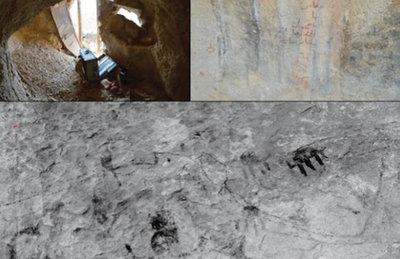M Najmuz Zafar
Source - http://www.muscatdaily.com/Archive/Oman/Khor-Kharfot-ruins-shed-light-on-period-pre-dating-Islam-3un2

(Top Left) A boulder cave with possible pirate activities. (Top Right and Below): Cave art of likely modern origin (Supplied photo)
Investigation into archaeological structures in various states of ruins at Khor Kharfot in Dhofar has highlighted the presence of a site pre-dating Islam.
The site has also been suggested as the possible location for Mormon Lehi to have built his ship that took him to Americas. Hidden from sight by steep ridges on either side, which rise sharply to a height of 500m, Khor Kharfot is a spring-fed lagoon where Wadi Sayq reaches the Arabian Sea.
The site is also important as previous expeditions have sought to find evidence here for a location of the City of Bountiful, as mentioned in the Book of Mormon.
The book makes several descriptions of the city, many of which fit the physical appearance of Khor Kharfot as it exists today. An expedition by British Exploring Society undertaken by Conor Bolas, Tony Han and Andrew Stokes-Rees in 2014 helped shed light on the site which has remained inaccessible because of its geography.
“From available evidence, it is likely that the site was home to a tribal society of Arabian inhabitants who primarily engaged in agriculture, with primitive forms of religion and spiritual practices. Fishing may have been a source of income with proximity to the sea and sustenance would also likely have come from the surrounding natural sources, wild foraging and hunting,” said the researchers in their study
Many of the structures recorded would have been simple dwellings for people, while there are several structures that seem to have had defensive uses. “Some of the rocks used are extremely large and have been quite obviously placed as a wall. The high point also suggests a look-out or stronghold area as if attacked by raiders from the sea,” said Bolas.
The site is strewn with several burial sites, with a few on cliff top suggesting spiritual significance or reserved for individuals of importance in society.
“One site in particular is clearly a burial tomb on the east side of the lagoon, beside the seafront. Significant stonework is visible within the collapsed walls of the tomb, detailing a square inner wall, roughly 8.5x8.5m. This tomb is likely the burial site of member(s) of great importance as work has gone into its structure, possible a religious leader or nobility. It is this site that has been suggested as the possible location for the passing through of the Mormon Lehi,” he said.
The researchers stated that it is likely that the society was pushed from the area by climactic conditions, as the climate got drier and hotter, with increasingly unpredictable flash flooding in the Khareef season.
“It is estimated that the ruins pre-date modern-day Islamic religious practices. Evidence of this has come from the lack of any clear mosque like building and the presence of cliff top sites of no obvious relevance to dwellings – likely to have ritualistic or spiritual significance, unlike the practices of modern Islam,” said Bolas.